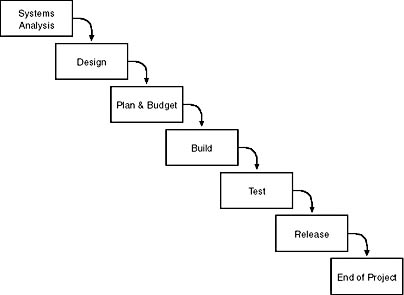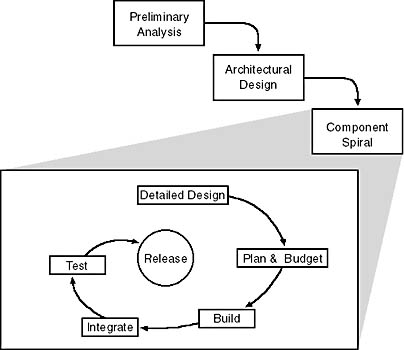Life Cycle Models
Once upon a time, systems analysts used a paradigm for the development process known as the "waterfall model." There are several versions of this model. A reasonably simple one is shown in Figure 6-1.
The process begins with systems analysis, sometimes called requirements analysis, since it focuses on what the organization and the users require the system to do. Once the systems analysis has been completed and approved, the entire system is designed in detail. This phase is followed by planning and budgeting, and then the entire system is built, tested, and released.

Figure 6-1. The waterfall model.
The waterfall model is aesthetically pleasing. Each activity is completed and approved before the next one is begun, and the model allows a fine degree of control over budgets, staffing, and time. Deliver a waterfall project on time and on budget, and your clients will probably love you.
The problem, of course, is that reality is hardly ever this neat. The model assumes that all the information required to complete a task is available during the performance of that task, and makes no allowance for new information coming to light later in the process. With the possible exception of very small systems, this situation is unlikely in the extreme.
The waterfall model also doesn't allow for changes in business requirements during the course of the project. To assume that a system that met the business's needs at the beginning of a project will still meet them at the end of a two-year or three-year development process is foolhardy. Your clients will not love you for delivering a useless system, even if it is on time and on budget.
Understand, however, that the activities identified in the waterfall model are perfectly sound. In fact, omitting any of them from a development project is a recipe for disaster. The problem with the model is its linearity, its assumption that each phase need never be reexamined once it has been completed.
Several alternative life cycle models have been proposed to deal with the problems in the waterfall model. The spiral model assumes multiple iterations of the waterfall, each one expanding the scope of the previous iteration, as shown in Figure 6-2.

Figure 6-2. The spiral model.
The problem with the spiral model is that when it is strictly applied the entire scope of the project is not considered until very late in the development project, and there is a (not insignificant) chance that later iterations will invalidate earlier work. This has always seemed to me a recipe for blown budgets and frustrated developers. This situation is particularly dangerous for database projects, where expansions in scope can change the semantics of the data and a change in the database schema can require unexpected changes throughout the system.
The model that I prefer for large systems, and use in my own work, is variously described as incremental development or evolutionary development, and is shown in Figure 6-3.

Figure 6-3. The incremental development model.
In this model, which is in many ways simply a variation on the spiral model, the preliminary analysis is performed for the entire system, not just a portion of it. This is followed by an architectural design, again of the whole system. The goal of the architectural design is to define individual components that can be implemented more or less independently, and to describe the interactions and interdependencies between these components. The detailed design and implementation of each component is then performed using whatever model seems most appropriate. I use the spiral model for this phase, as shown in Figure 6-3, because it allows greater flexibility in design and implementation.
Note that the spiral here includes an additional task, integration. Component integration is implicit in the spiral model as well, of course, but it's been my experience that the task is rather more complex using the incremental development approach. This is also one of the reasons I prefer to use the spiral model during component development. Deferring the detailed design of a component until just before it is to be developed allows you to accommodate any insights gained during the integration of previous components, and hopefully avoid any of the problems you might have encountered during the integration.
The incremental development model assumes that any large system can be decomposed into distinct components, and this is not necessarily the case for all systems. It can also result in a lot of "scaffolding" code. For example, say that a data entry screen is supposed to make a call to a Microsoft ActiveX component that will perform a lookup on a customer code and take some action if a match is found, but that the ActiveX component hasn't yet been built. The development team will have to build some dummy code that allows the call to be made without error. Complex systems can include a substantial amount of scaffolding like this.
Additionally, there's always a chance that the ActiveX component will never be implemented; perhaps the budget doesn't stretch that far, or you later determine that it wasn't such a good idea after all. If you don't plan for this possibility, you could be distributing components whose only function is to keep other components from failing. Not an elegant situation, and certainly not one you'd like to explain to a maintenance programmer.
Because the analysis and architectural design are performed at the beginning of the project, there is the risk of them becoming obsolete, which as you will recall is one of the main disadvantages of the waterfall model. For this reason, it's important to review these two steps—particularly the requirements analysis, since it's more likely to change—before commencing the detailed design of each component. It's often a pleasant surprise how changes in requirements can be accommodated by changes to as-yet-undeveloped components, or even by changing the order in which new components are developed, without invalidating previous development work.
But the incremental development model does have several advantages. Because a "big picture" of the system is defined at the outset, the chances of wasted development work are minimized. Because large projects are decomposed into smaller components, the individual component projects become easier to manage. And by breaking the system into individual components, you have a good chance of being able to deliver some core functionality to your users early in the project. This allows the system to start paying for itself and also provides a mechanism for soliciting user input to be fed into subsequent development efforts.
EAN: 2147483647
Pages: 124